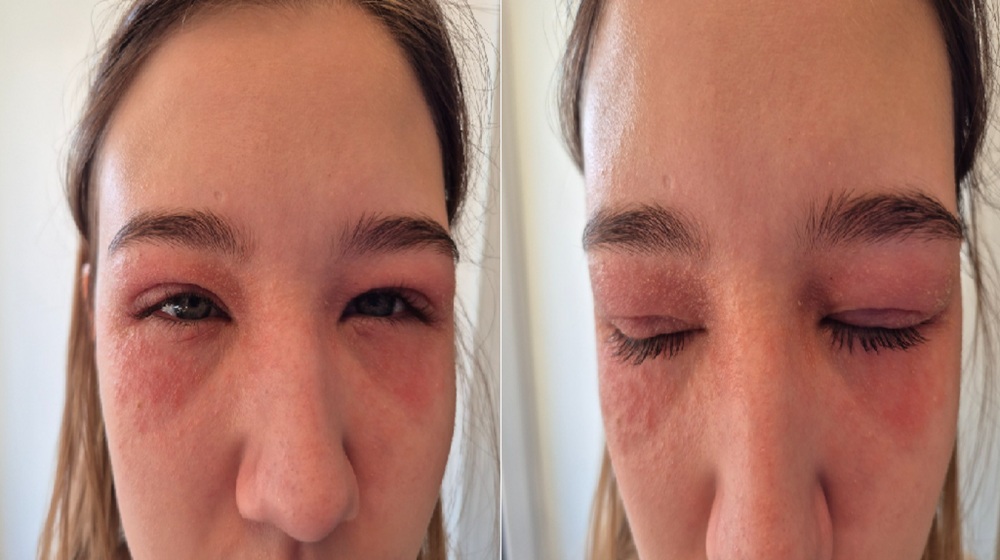Seventeen-year-old Hana never imagined that a simple application of false eyelashes could turn into a nightmare.
“Like many girls today, I also wanted to try false eyelashes. I used the lashes and the glue that came with them, but just a few minutes after applying, I felt a slight burning sensation on my upper eyelid. I quickly removed them, but it was too late. I started to feel itching, redness, and swelling, which only got worse. The next day, my eyes were so swollen I couldn’t open them, and the itching spread. The doctor prescribed moisturizing wipes and artificial tears, but after a week, there was no improvement. The swelling didn’t go down, and my vision was almost completely lost. After two weeks of feeling hopeless, I found online that Vaseline can help with dermatitis and rashes. After just one day, the swelling nearly went away, and the itching disappeared. This experience taught me a valuable lesson, and I have decided to avoid eyelash glue in the future. Instead, I will look for safer alternatives to enhance my lashes.”

Figure 1,2: Hana’s reaction to the false eyelashes (Source: Personal source)
Hana’s story is a wake-up call about the potential risks associated with eyelash adhesives, which many of us use without a second thought. False eyelashes are often seen as a quick and easy way to enhance our appearance, but the glue that holds them in place can contain chemicals that irritate the sensitive skin around our eyes, potentially leading to serious reactions. Understanding the ingredients and risks involved in eyelash glues is essential to ensuring that our beauty routines don’t come at the expense of our health.
In Europe, cosmetic products, including eyelash glue, are regulated [1,2]. This means products on the market must be safe if used properly. Still, because our eyes are so sensitive, it’s important to be extra careful [1,3].
Ever felt your eyes getting itchy after applying false lashes? It might not be the lashes—it could be the glue!
Even though the lashes themselves may seem harmless, the glue often contains ingredients that need closer attention. Mixing synthetic lashes with strong adhesives can sometimes trigger allergic reactions, irritation, or even more severe complications [1,3].
GG tip: Always check the glue’s ingredients and follow the care instructions! If not used properly, you risk allowing harmful bacteria or fungi to grow on the lashes, which could lead to eye infections.
Let’s take a quick look at what’s inside the glue. We checked out six different eyelash glues and found that most of them contain water, binding agents, and preservatives. And how often is each component present in the glue? Check below.
| Glue components | How often is this component present in the glue |
| Aqua | 100 % |
| Phenoxyethanol | 83 % |
| Acrylates/Ethylhexyl Acrylate Copolymer | 83 % |
| Ethylhexylglycerin | 67 % |
| Tocopherol | 67 % |
| Alcohol Denat. | 17 % |
| Methoxyisopropyl Acetate | 17 % |
| Nitrocellulose | 17 % |
| Isopropyl Alcohol | 17 % |
| Denatonium Benzoate | 17 % |
But what do these ingredients actually do? If you’re curious about the chemistry, read on to learn more about the 5 most common ingredients that were found.🙂
Aqua (water) is the most common and completely safe ingredient in cosmetics. It’s just water — and yes, it’s harmless, according to most reports to ECHA [4].
Phenoxyethanol is a synthetic preservative that prevents bacterial growth and extends shelf life. While effective, it can sometimes cause skin irritation or allergic reactions — especially in people with sensitive skin. EU regulations classify it as harmful if swallowed and note it may cause serious eye irritation or affect breathing in high concentrations [5,6].
Acrylates/Ethylhexyl Acrylate Copolymer is an ingredient commonly found in eyelash adhesives, helping the glue to stay in place and bond effectively. It also acts as a film-forming agent. While it is generally considered safe for most people, it can be a concern for those with sensitive skin [7, 8]. The downside? It’s a form of microplastic — a synthetic ingredient that doesn’t break down easily in nature. And microplastics? Big no-no for the environment.
Ethylhexylglycerin is a skin-conditioning agent and often used as a preservative booster. It’s generally considered safe, but it can sometimes cause mild eye irritation. On the environmental side, it’s not considered harmful, so no major concerns here [9].
Tocopherol (Vitamin E) is a well-known antioxidant. It’s generally safe to use, but like with many ingredients, some people may get a mild allergic reaction [10].
Most eyelash glues are safe for most people, but if you have sensitive skin or use them often, reactions can happen. It’s always recommended to check for any potential allergies before using eyelash adhesives and to follow the manufacturer’s instructions.
GG tip: Before applying any glue or lashes, do a quick patch test on your wrist. A few extra seconds could save you from hours of irritation!
So, next time you grab that lash glue, remember: your eyes deserve the best care! Always follow the instructions, do a patch test, and pay attention to the ingredients. And hey, don’t forget to embrace your natural lashes—you’re beautiful just the way you are!
Sources:
[1] Brambilla E., Crevani M., Petrolini V. M., Scaravaggi G., Di Primo M., Roda E., Locatelli C. A. (2020). Exposure to Nail and False Eyelash Glue: A Case Series Study. International Journal of Environmental Research and Public Health, 17(12), 4283. doi:10.3390/ijerph17124283.
[2] Regulation (EC) No 1223/2009 of the European Parliament and of the Council of 30 November 2009 on cosmetic products (recast) (Text with EEA relevance). Document 32009R1223. https://eur-lex.europa.eu/legal-content/EN/TXT/?uri=CELEX%3A32009R1223.
[3] Hamilton, V. (2021). What to Know About Fake Eyelashes. WebMD. https://www.webmd.com/beauty/features/what-to-know-fake-eyelashes.
[4] European Chemicals Agency (ECHA). Substance information: Aqua. https://echa.europa.eu/cs/substance-information/-/substanceinfo/100.028.902 Accessed 18 March.
[5] European Chemicals Agency (ECHA). Substance information: Phenoxyethanol. https://echa.europa.eu/cs/substance-information/-/substanceinfo/100.004.173 Accessed 18 March.
[6] Environmental Working Group. Phenoxyethanol. EWG Skin Deep. https://www.ewg.org/skindeep/ingredients/704811-PHENOXYETHANOL/ Accessed 15 January.
[7] European Commission. Substance information: Acrylates/Ethylhexyl Acrylate Copolymer. COSING. https://ec.europa.eu/growth/tools-databases/cosing/details/54277 Accessed 18 March.
[8] Environmental Working Group. Acrylates/Ethylhexyl Acrylate Copolymer. EWG Skin Deep. https://www.ewg.org/skindeep/ingredients/716378-ACRYLATESETHYLHEXYL_ACRYLATE_COPOLYMER/ Accessed 15 January.
[9] ECHA Chemical Database (ECHACHEM) European Chemicals Agency. Ethylhexylglycerin. https://chem.echa.europa.eu/100.100.951/overview Accessed 9 June.
[10] European Chemicals Agency (ECHA). Tocopherols. https://echa.europa.eu/cs/registration-dossier/-/registered-dossier/12703?iuclidSection=1&infopanel=collapseComposition1#collapseComposition1_pointer Accessed 9 June.


0 Comments